Grilled Trout With Dill and Lemon
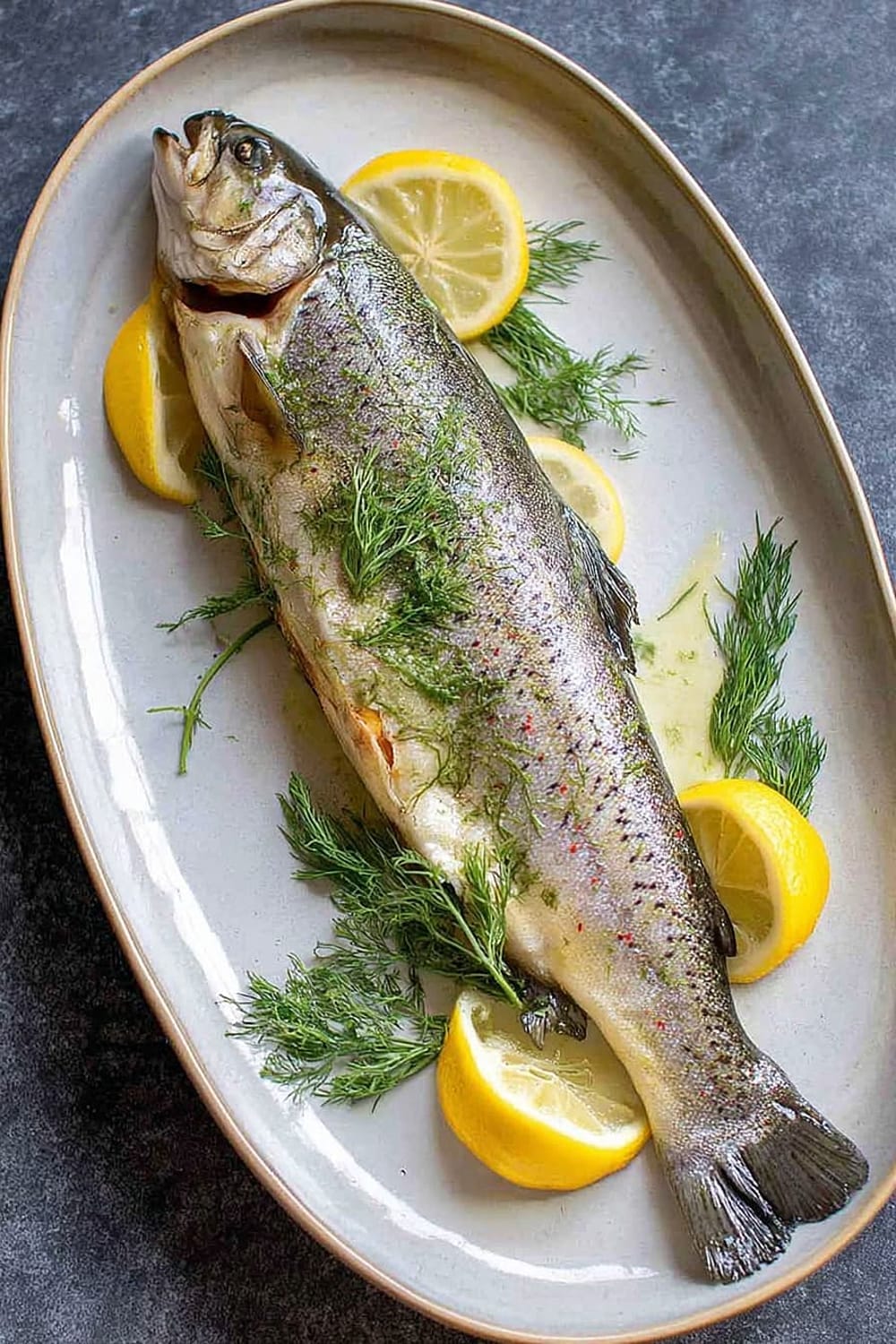
This is the kind of recipe that makes you look like a grill master without needing a culinary degree or even knowing what “medium-rare” means for fish.
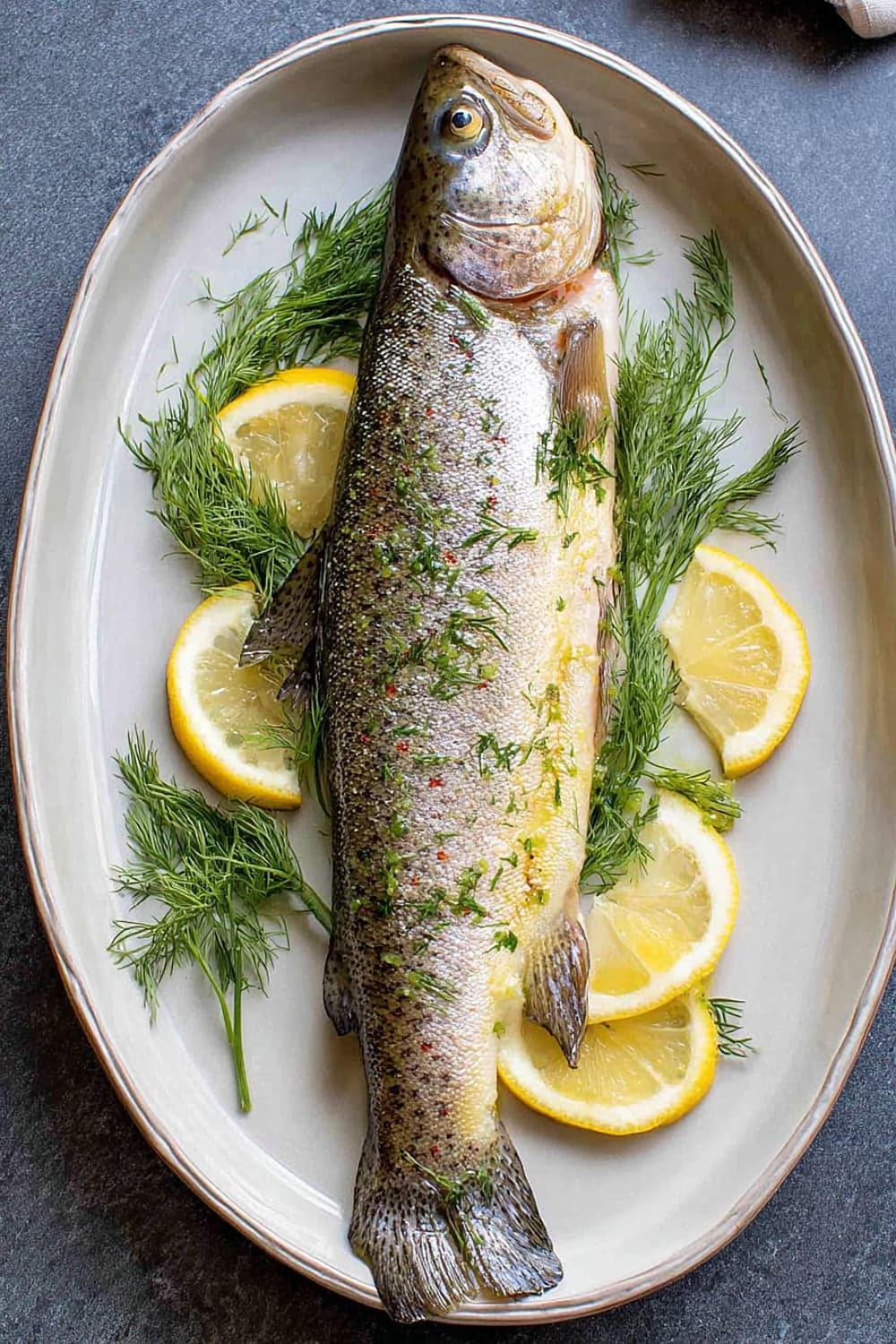
Fresh trout stuffed with bright lemon slices and aromatic dill creates this perfect balance of delicate, flaky fish with zesty, herbaceous flavors that’ll have your neighbors wondering what smells so incredible.
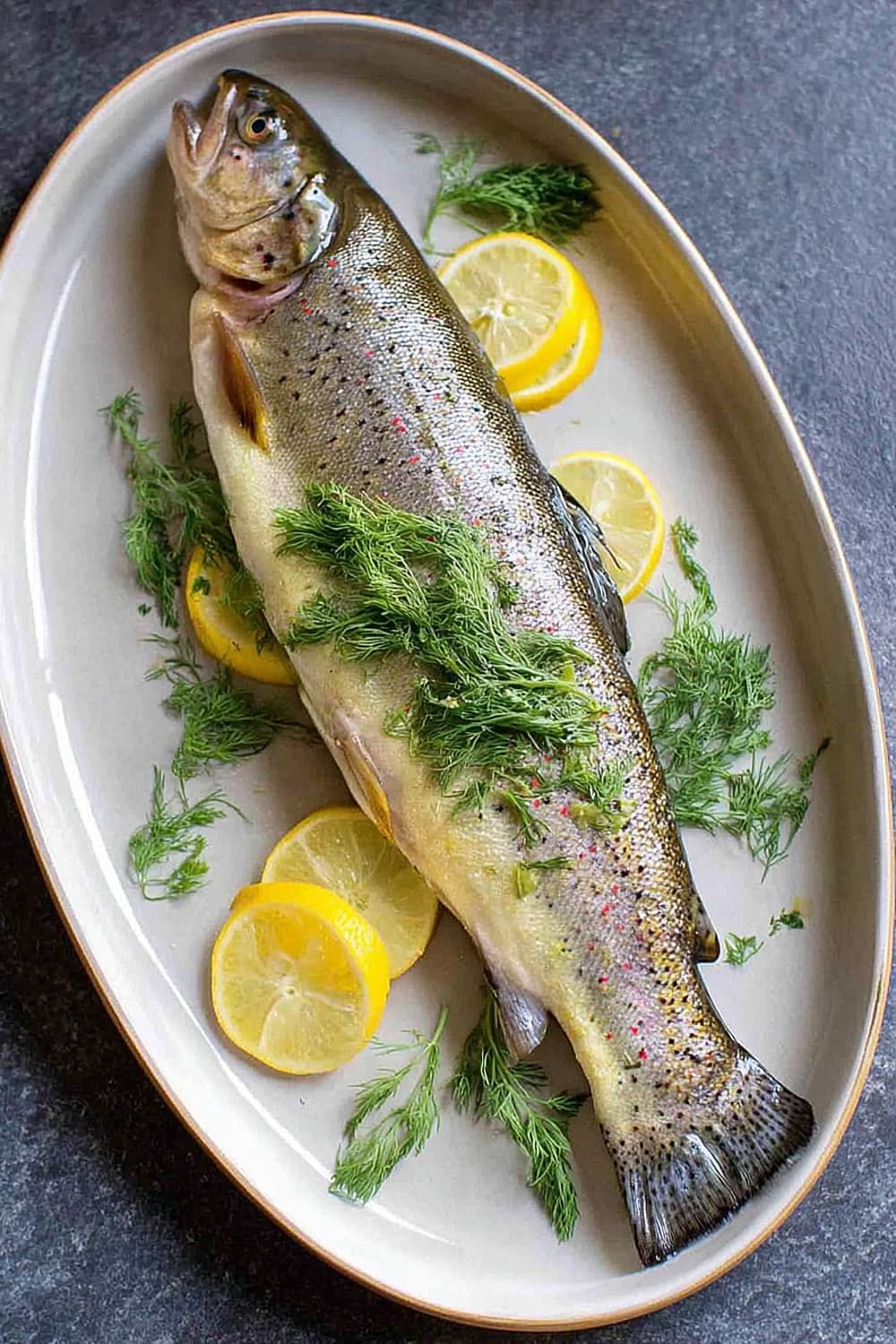
The aluminum foil boat technique is basically a foolproof cheat code – no fancy grill baskets required, no fish falling through the grates, just perfectly cooked trout every single time.
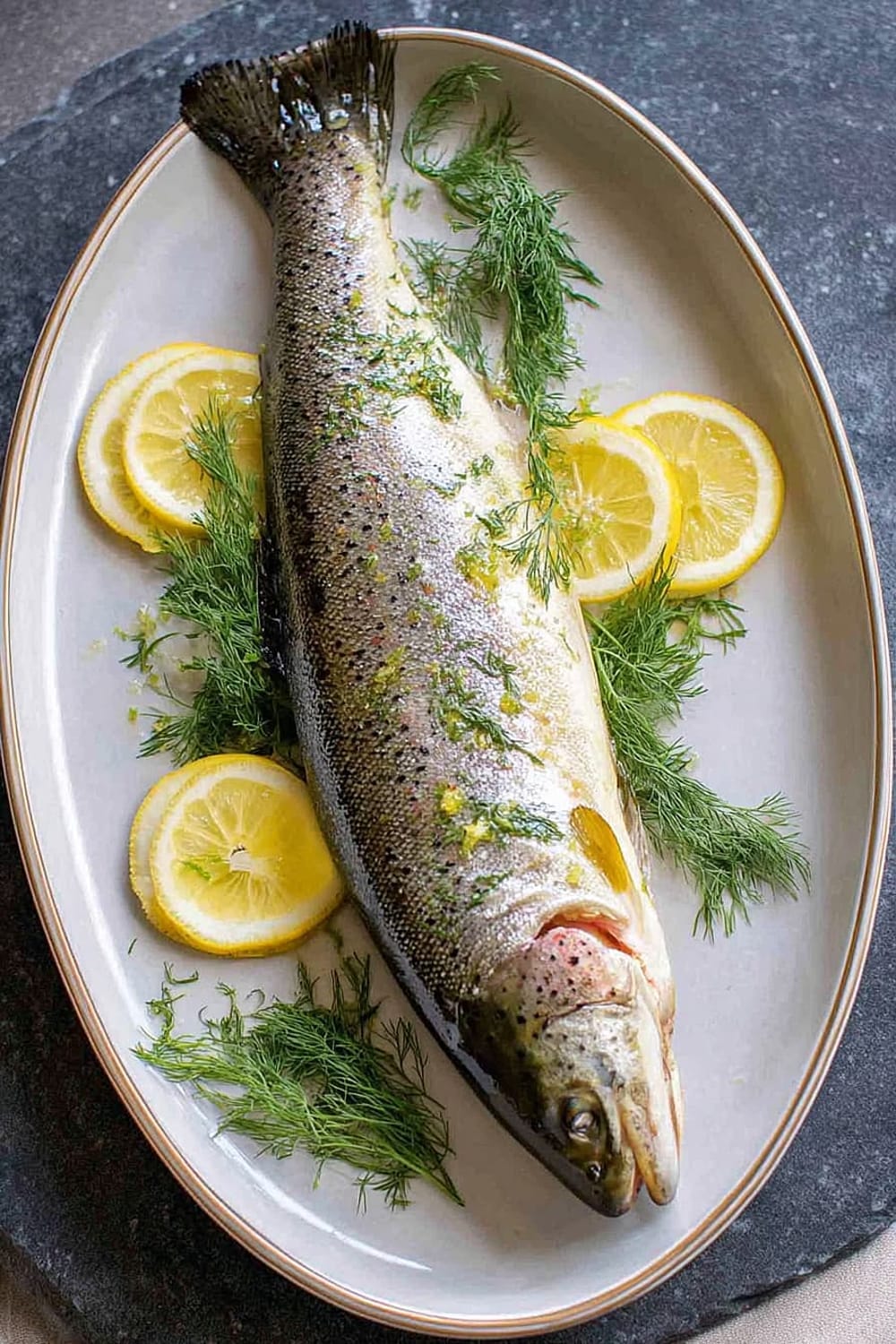
What makes this recipe absolutely brilliant is how the butter melts into the fish while the lemon slices steam from the inside, creating this amazing self-basting situation that keeps everything incredibly moist.
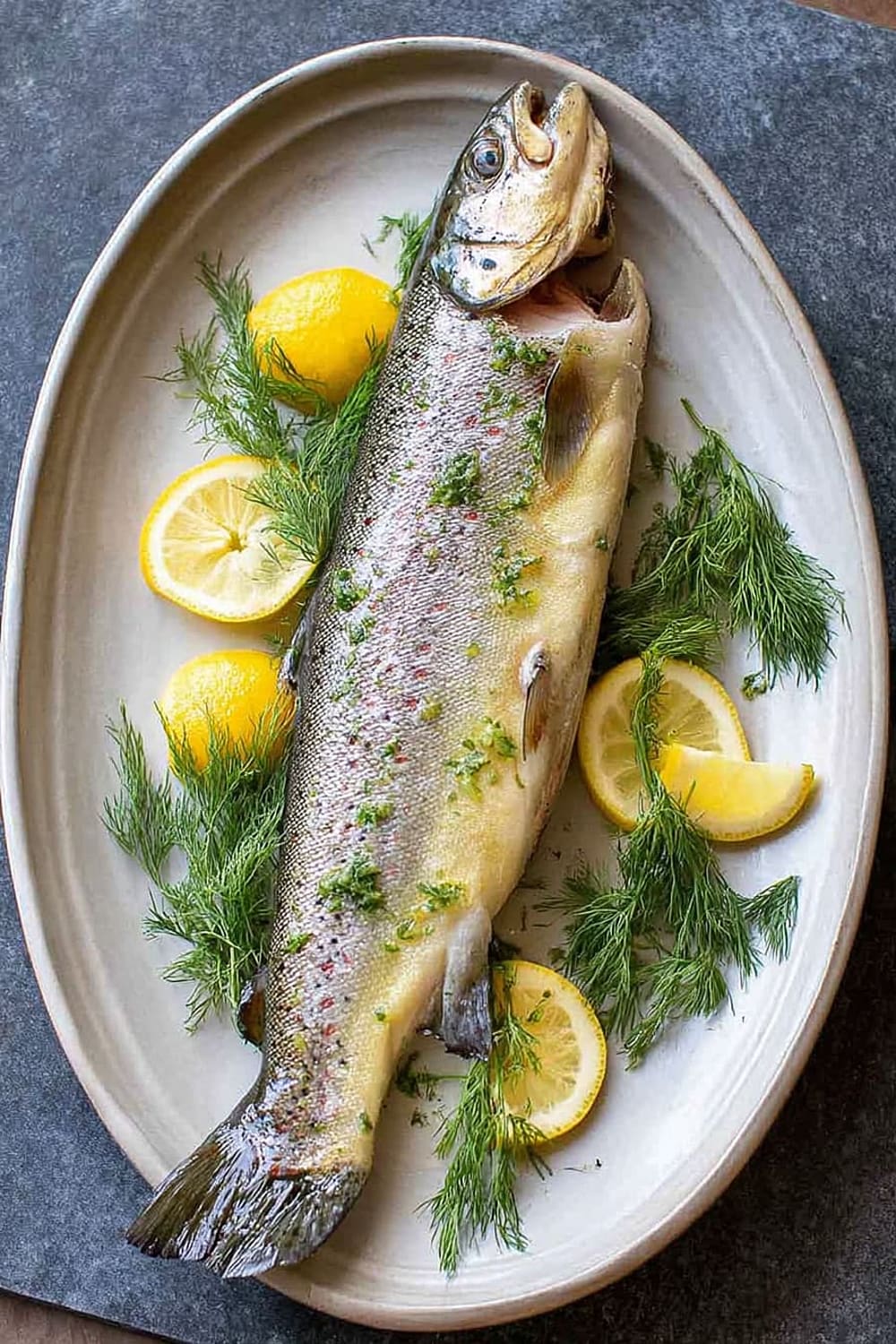
You’ll get restaurant-quality results with ingredients you probably already have, and the whole thing takes less than 35 minutes from start to finish.
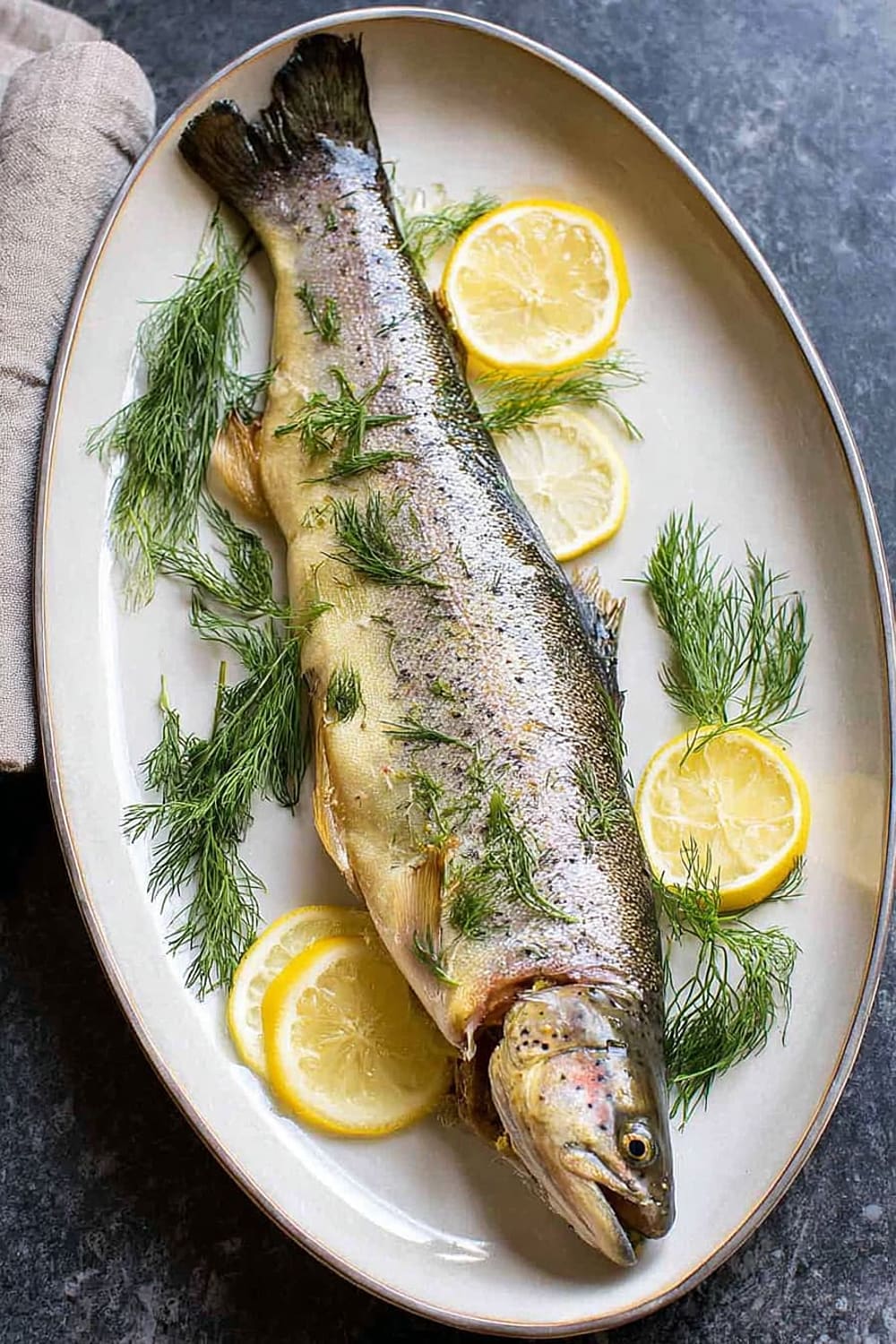
Prepare yourself for that ultimate compliment: “Wait, you actually grilled this yourself?” Yes, Karen, some of us can handle fire and fish without calling the fire department.
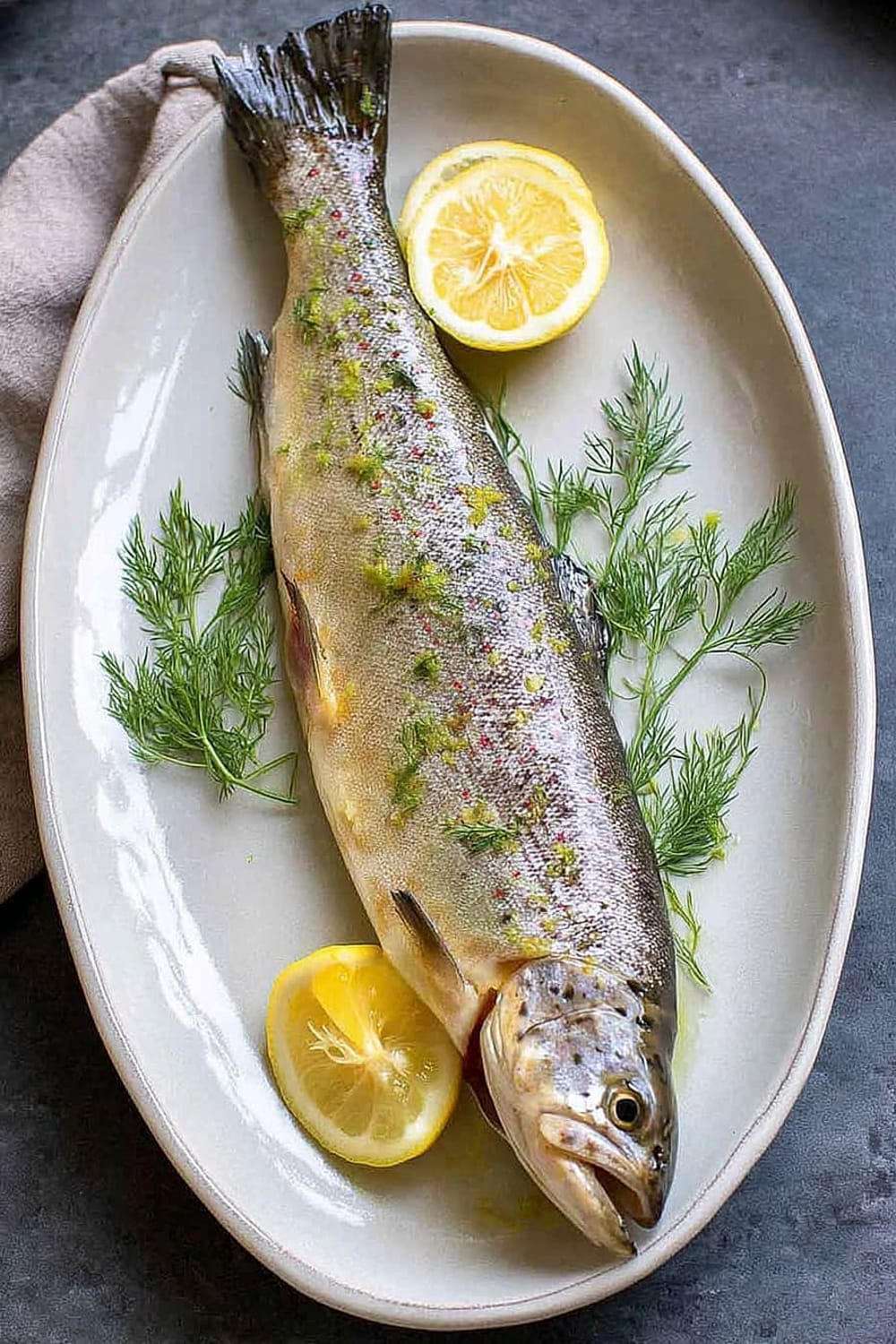
Ingredients
For the Trout
- 2 whole trout, boned and cleaned (butterflied), head and tail on or headless
- Extra virgin olive oil for coating and brushing
- Kosher salt to taste
- Freshly ground black pepper to taste
For the Stuffing
- 6 paper-thin slices fresh lemon, seeded
- Several sprigs fresh dill (or basil, tarragon, parsley, or other tender herbs)
- 1 teaspoon butter, cut into small cubes
For the Foil Boat
- Heavy-duty aluminum foil, doubled or tripled
- Additional extra virgin olive oil for coating the foil
Instructions
Prepare the Grill
- 1 Fire up your grill for direct high heat, ensuring you have one section that stays cool for indirect cooking. This two-zone setup is crucial for preventing the delicate trout from overcooking while ensuring it gets properly heated through.
Create the Aluminum Boat
- 2 While your grill heats up, construct a “boat” using heavy-duty aluminum foil. Double or triple layer the foil for extra durability – you don’t want any tears that could cause your fish to stick or fall apart.
- 3 Form a 1-inch rim around all edges of the foil, creating walls that will contain the cooking juices and prevent any olive oil from dripping onto the grill grates.
- 4 Coat the bottom of your foil boat generously with extra virgin olive oil. This creates a non-stick surface and adds flavor while preventing the delicate trout skin from tearing when you remove it later.
Prepare the Trout
- 5 Rinse the trout under cold running water and pat completely dry with paper towels. Any excess moisture will create steam and prevent proper seasoning adhesion.
- 6 Open each fish like a book and season the inside cavity generously with kosher salt and freshly ground pepper. The seasoning should be visible but not overwhelming.
- 7 Arrange the 6 lemon slices in a single layer inside each fish cavity, ensuring even distribution. The lemon will steam from the inside, infusing the fish with bright citrus flavor.
- 8 Top the lemon slices with fresh dill sprigs, then dot with the small butter cubes. The butter will melt and baste the fish from within while the herbs add aromatic complexity.
- 9 Close the fish over the stuffing, then brush both sides thoroughly with extra virgin olive oil. This exterior coating helps with browning and prevents sticking.
- 10 Carefully place the prepared trout in your aluminum foil boats, ensuring they sit flat and stable.
Grill the Trout
- 11 Position the foil boats on the hot side of the grill and cover immediately. Cook for exactly 3 minutes – you’ll notice the oil and fish juices starting to bubble, which indicates proper heat transfer.
- 12 Move the boats to the cool side of the grill for indirect cooking. Cover and continue cooking for 3-5 more minutes until the fish is just cooked through. The flesh should be opaque and flake easily when tested with a fork, with an internal temperature of 145°F (63°C).
Recommended Equipment and Kitchen Tools
Recommended Tools (for best results)
- Heavy-duty aluminum foil – Essential for creating leak-proof boats that won’t tear during cooking
- Instant-read thermometer – Takes the guesswork out of doneness; trout should reach 145°F (63°C) internally
- Long-handled tongs – Safely move the foil boats without puncturing or dropping them
- Silicone basting brush – Perfect for evenly coating the fish with olive oil without tearing delicate skin
Helpful Upgrades
- Digital probe thermometer – Allows continuous monitoring without opening the grill lid
- Fish spatula – Wide, thin blade makes transferring cooked trout from foil to plate much easier
- Microplane grater – If you want to add fresh lemon zest for extra citrus punch
Nice-to-Have Options
- Grill basket – Alternative to foil boats if you prefer direct grill contact, though requires more skill
- Cedar planks – Can substitute for foil boats and add subtle smoky flavor
- Kitchen scale – Ensures consistent seasoning ratios if scaling the recipe up or down
Recipe Variations and Dietary Modifications
Herb Variations
- Fresh basil – Creates an Italian-inspired flavor profile, especially good with cherry tomatoes
- Tarragon – Adds a subtle anise note that pairs beautifully with the lemon
- Fresh parsley – Classic and clean, won’t overpower the delicate fish flavor
- Thyme sprigs – Earthy and aromatic, perfect for a more rustic presentation
Citrus Alternatives
- Lime slices – Swap lemon for lime for a more tropical, zesty flavor
- Orange slices – Milder citrus that works well with herbs like rosemary or sage
- Grapefruit segments – Adds subtle bitterness and complexity
Cooking Method Modifications
- Oven version – Bake foil boats at 350°F (175°C) for 12-15 minutes if no grill available
- Stovetop adaptation – Use a large cast iron skillet with lid over medium heat
- Campfire cooking – Perfect for outdoor camping, just manage coals for indirect heat
Flavor Enhancements
- Garlic butter – Mix minced garlic into the butter cubes for extra savory depth
- White wine – Add 1 tablespoon to each foil boat for steam and flavor
- Capers – Sprinkle inside with the herbs for Mediterranean flair
Nutritional Information and Health Benefits
Key Nutritional Highlights
This recipe provides approximately 280 calories per serving, with the majority coming from high-quality protein and healthy fats. Each serving delivers roughly 35 grams of complete protein, making it excellent for muscle maintenance and satiety. The minimal use of added fats keeps the dish light while the olive oil provides beneficial monounsaturated fats.
Health Benefits of Main Ingredients
Fresh trout is an exceptional source of omega-3 fatty acids, particularly EPA and DHA, which support heart health and brain function. Unlike farm-raised salmon, trout typically has lower mercury levels while providing similar nutritional benefits. The fresh dill contains antioxidants and has natural antimicrobial properties, while lemons provide vitamin C and citrus bioflavonoids that enhance iron absorption from the fish. Extra virgin olive oil contributes vitamin E and polyphenols with anti-inflammatory properties.
Dietary Considerations
This recipe is naturally gluten-free, dairy-free (except for the small amount of butter), and keto-friendly with approximately 2 grams of carbohydrates per serving. It’s suitable for paleo, Mediterranean, and anti-inflammatory diets. The only common allergen is fish, making it accessible for most dietary restrictions.
Smart Swaps and Ingredient Substitutions

Fish Substitutions:
- Whole trout → Salmon fillets (adjust cooking time to 4-6 minutes per side)
- Butterflied trout → Whole branzino or red snapper (similar cooking times)
- Fresh trout → Frozen trout (thaw completely and pat extra dry)
Herb Alternatives:
- Fresh dill → Dried dill (use 1 teaspoon instead of several sprigs)
- Fresh herbs → Herb blends like Italian seasoning or herbs de Provence
- Dill → Fennel fronds for similar anise-like flavor
Fat Substitutions:
- Butter → Ghee for dairy-free option with higher smoke point
- Extra virgin olive oil → Avocado oil for neutral flavor and high heat tolerance
- Olive oil → Melted coconut oil for subtle tropical notes
Citrus Swaps:
- Fresh lemon → Bottled lemon juice (use 2 tablespoons per fish)
- Lemon slices → Lemon zest mixed with herbs for concentrated flavor
- Fresh citrus → Preserved lemons for more intense, salty flavor
Make It Diabetes-Friendly
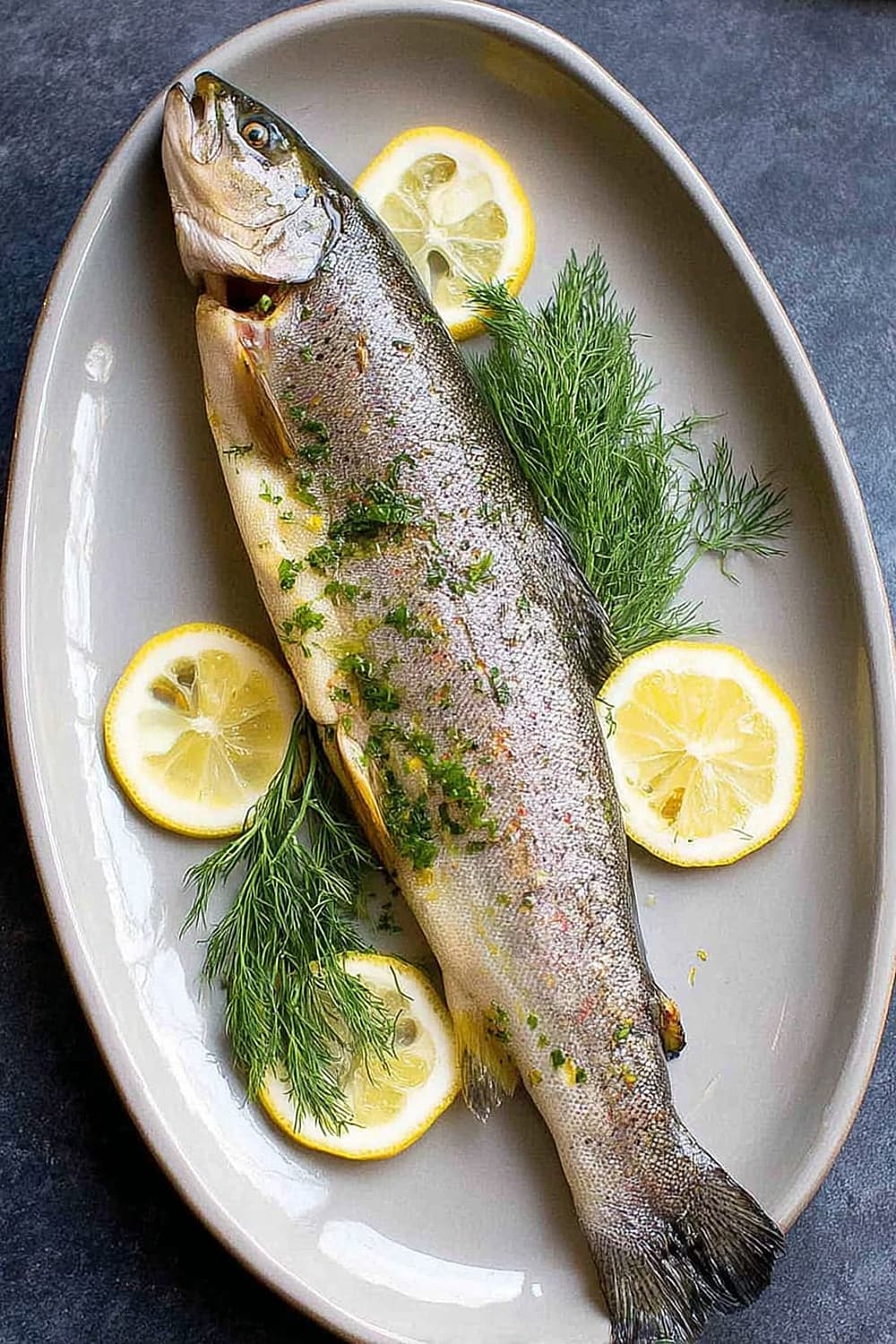
Naturally Low-Carb Benefits:
- Total carbohydrates: Approximately 2 grams per serving from lemon and herbs
- Net carbs: Less than 1 gram after accounting for fiber
- No added sugars or refined carbohydrates in the base recipe
Blood Sugar Impact:
- High protein content (35g per serving) helps stabilize blood glucose levels
- Healthy fats from olive oil and fish slow digestion and prevent spikes
- Minimal carbohydrate load makes this suitable for all phases of diabetes management
Portion & Timing Tips:
- Standard serving (1 whole trout) provides complete meal satisfaction
- Pair with non-starchy vegetables like grilled asparagus or sautéed spinach
- Ideal for lunch or dinner when paired with a small salad dressed with olive oil
Enhancement Suggestions:
- Add extra herbs instead of starchy sides for flavor without carbs
- Serve with cauliflower rice or zucchini noodles for volume
- Include healthy fats like avocado slices to further slow digestion
Perfect Pairing Suggestions
Beverage Pairings
A crisp Sauvignon Blanc or Pinot Grigio complements the lemon and dill beautifully without overwhelming the delicate fish. For beer lovers, a wheat beer or light pilsner provides refreshing contrast. Non-alcoholic options include sparkling water with lemon or iced green tea with mint.
Side Dish Recommendations
Grilled asparagus with olive oil and garlic creates a perfect textural contrast while staying on theme. Wild rice pilaf adds substance without competing flavors, or try roasted fingerling potatoes with rosemary. A simple arugula salad with lemon vinaigrette echoes the citrus notes while adding peppery freshness.
Complete Meal Ideas
Start with bruschetta or olive tapenade to build Mediterranean flavors. Follow the trout with grilled zucchini and herb-roasted cherry tomatoes. For dessert, lemon sorbet or fresh berries with mint keep the meal light and seasonal.
Occasion Suggestions
Perfect for summer entertaining when you want impressive results without heating up the kitchen. Ideal for romantic dinners due to the elegant presentation, or family cookouts where the foil boat method ensures success for novice grillers.
Pro Tips and Troubleshooting
Professional Techniques
Score the skin lightly in a crosshatch pattern before seasoning to prevent curling and ensure even cooking. Always oil the foil generously – this isn’t the place to skimp, as it prevents sticking and adds flavor. Check doneness by gently lifting the flesh with a fork; it should flake easily and be opaque throughout.
Common Mistake Prevention
Never skip the two-zone grill setup – direct high heat the entire time will char the outside while leaving the inside raw. Don’t overcrowd the foil boats; each fish needs space for proper heat circulation. Resist the urge to flip the fish; the foil boat method cooks evenly from all sides.
Storage and Reheating
Leftover trout keeps refrigerated for 2-3 days and reheats beautifully in a 300°F (150°C) oven for 5-7 minutes. For meal prep, prepare the foil boats ahead and refrigerate up to 4 hours before grilling. The fish can also be served cold in salads or flaked into pasta dishes.
Scaling the Recipe
This recipe doubles or triples easily – just prepare additional foil boats and stagger cooking times if your grill space is limited. For larger crowds, consider using sheet pans in the oven at 350°F (175°C) for 12-15 minutes.